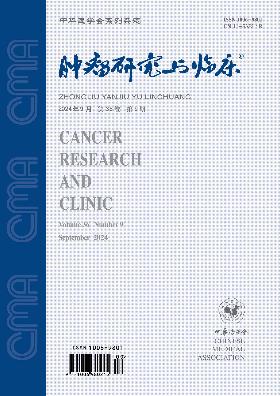Comparison of epidural anesthesia with paravertebral nerve block for non-intubated uniportal video-assisted thoraeoseopic surgery
Q4 Medicine
引用次数: 0
Abstract
目的 比较硬膜外麻醉与椎旁神经阻滞非气管插管单孔胸腔镜手术的效果。 方法 选择2017年11月至2019年6月锦州医科大学附属第一医院收治的45例采用非气管插管麻醉单孔胸腔镜手术的肺部良恶性肿瘤患者,采用随机数字表法分为椎旁神经阻滞组(22例)与硬膜外麻醉组(23例)。麻醉诱导前,椎旁神经阻滞组均于超声引导下阻滞胸3~6棘突旁神经根;硬膜外麻醉组均于胸6~7或7~8间隙行硬膜外穿刺置管麻醉。比较两组手术时间、术中出血量、术后定向力恢复时间、下床活动时间、带管时间、出院时间及相关并发症。 结果 两组患者手术时间、术中出血量差异均无统计学意义(均P>0.05)。与硬膜外麻醉组相比,椎旁神经阻滞组术后定向力恢复时间[(7.22±2.20)min比(18.80±5.06)min]、下床活动时间[(11.45±3.01)h比(21.90±4.61)h]、带管时间[(2.77±0.81)d比(5.47±1.31)d]、出院时间[(3.68±0.84)d比(6.17±1.03)d]均缩短,两组差异均有统计学意义(t值分别为-9.874、-8.763、-8.282、-7.594,均P<0.05)。椎旁神经阻滞组术后未发生低氧血症、低血压、肺部并发症、恶心、呕吐、尿潴留等相关并发症。 结论 非气管插管单孔胸腔镜手术中采用椎旁神经阻滞术后恢复快、并发症少,临床上可优先选择,有助于快速康复。硬膜外麻醉与椎旁神经阻滞在非插管单门静脉胸腔镜手术中的比较
Objective To compare the effects of epidural anesthesia and paravertebral nerve block on non tracheal intubation single hole thoracoscopic surgery. Method: A total of 45 patients with benign and malignant lung tumors who underwent non tracheal intubation anesthesia single hole thoracoscopic surgery and were admitted to the First Affiliated Hospital of Jinzhou Medical University from November 2017 to June 2019 were randomly divided into a paravertebral nerve block group (22 cases) and an epidural anesthesia group (23 cases) using a random number table method. Before induction of anesthesia, the paravertebral nerve block group was guided by ultrasound to block the thoracic 3-6 spinous nerve roots; The epidural anesthesia group underwent epidural puncture and catheterization anesthesia in the 6-7 or 7-8 intervals of the chest. Compare the surgical time, intraoperative bleeding volume, postoperative recovery time of directional force, time of getting out of bed activity, time of catheterization, discharge time, and related complications between the two groups. There was no statistically significant difference in surgical time and intraoperative bleeding between the two groups of patients (both P>0.05). Compared with the epidural anesthesia group, the paraspinal nerve block group had shorter postoperative directional recovery time [(7.22 ± 2.20) minutes compared to (18.80 ± 5.06) minutes], ambulation time [(11.45 ± 3.01) hours compared to (21.90 ± 4.61) hours], tube insertion time [(2.77 ± 0.81) days compared to (5.47 ± 1.31) days], and discharge time [(3.68 ± 0.84) days compared to (6.17 ± 1.03) days], The differences between the two groups were statistically significant (t-values were -9.874, -8.763, -8.282, -7.594, all P<0.05). In the paravertebral nerve block group, there were no postoperative complications such as hypoxemia, hypotension, pulmonary complications, nausea, vomiting, and urinary retention. Conclusion: The use of paravertebral nerve block in non tracheal intubation single hole thoracoscopic surgery has fast recovery and fewer complications, and can be prioritized in clinical practice, which is helpful for rapid recovery.
本文章由计算机程序翻译,如有差异,请以英文原文为准。
求助全文
约1分钟内获得全文
求助全文
来源期刊

肿瘤研究与临床
Medicine-Oncology
CiteScore
0.10
自引率
0.00%
发文量
7737
期刊介绍:
"Cancer Research and Clinic" is a series of magazines of the Chinese Medical Association under the supervision of the National Health Commission and sponsored by the Chinese Medical Association.
It mainly reflects scientific research results and academic trends in the field of malignant tumors. The main columns include monographs, guidelines and consensus, standards and norms, treatises, short treatises, survey reports, reviews, clinical pathology (case) discussions, case reports, etc. The readers are middle- and senior-level medical staff engaged in basic research and clinical work on malignant tumors.
 求助内容:
求助内容: 应助结果提醒方式:
应助结果提醒方式:


